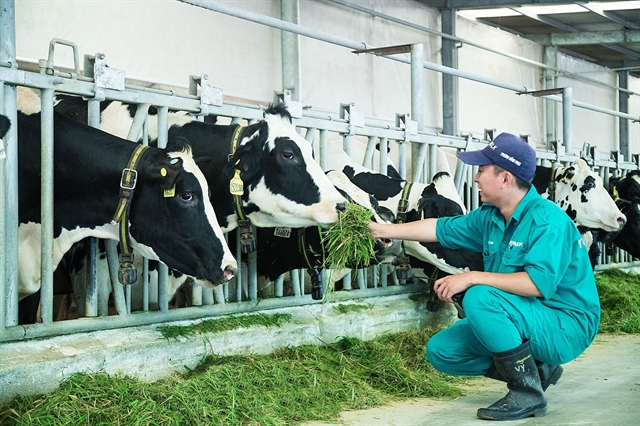 Economy
Economy


|
| The total production value of the livestock industry in 2022 was estimated at over VNĐ506 trillion, up 5.5 per cent over the figure in 2021. — Photo nhachannuoi.vn |
HÀ NỘI — Việt Nam's livestock industry expects to face less difficulties this year, especially when China loosens COVID-19 control measures.
After nearly three years of persisting with a zero-COVID policy, China has eased quarantine measures and reopened its borders from January 8.
The gradual easing of disease restrictions by the world's second-largest economy will affect the economies of the ASEAN region, especially Việt Nam, China's largest trading partner in the ASEAN bloc since 2016, according to the Agribank Securities Co (Agriseco).
At present, Việt Nam is under negotiation to get permission for official exports of pork to China.
Saigon Securities Incorporation (SSI) experts forecast that cross-border trade will support hog prices in 2023. Pork exports through official channel from Việt Nam to China could also enjoy this advantage.
Commercial farms developed under the 3F model (Feed-Farm-Food) will be the main beneficiaries of the permission for the official export of pork to China.
However, it is necessary to meet many regulations related to origin traceability and food safety before asking permission to export.
Analysts at VNDirect Securities Joint Stock Company also said that the difficulties of pork producers would ease from 2023, thanks to the forecasted pork price increase of 5 per cent when the demand for eating outside recovers.
In addition, grain prices are likely to decrease as exporting countries increase supply and Ukraine's grain products are transported again after having an agreement ending the blockage of the country's ports and reduction in fertiliser prices.
According to VNDirect, domestic animal feed prices will decrease gradually in 2023.
Another factor supporting pig farming and processing enterprises is an increase in consumption demand when consumers' real income increases. Meanwhile, the number of international tourists this year is expected to grow at a rate of 84 per cent in the second quarter and 100 per cent in the fourth quarter, creating a strong recovery of entertainment, accommodation and catering services.
Experts from VNDirect believe that the pig farming and processing enterprises will record revenue growth this year. These businesses will likely see a recovery in the growth rates of gross profit, such as Dabaco Vietnam Group Joint Stock Company (Dabaco), Masan Joint Stock Company, BaF Vietnam Agriculture Joint Stock Company, and Hoàng Anh Gia Lai Group Joint Stock Company.
However, the pig farming enterprises still face a risk of increasing global grain prices again due to the prolonged tension between Russia and Ukraine that may affect commodity shipping activities in the Black Sea.
Việt Nam imports about 80 per cent of input materials for animal feed production, so the increase in the USD/VNĐ exchange rate also leads to the higher production cost of animal feed.
The outbreak of African swine fever has not been controlled completely at all household farms. However, it will not affect the total pork supply because the outbreak is not as severe as it was in the past and vaccination for pigs is expected to begin in 2023 upon completion of the pilot phase.
Nguyễn Quốc Đạt, vice chairman of the Vietnam Livestock Association, said that in 2022, the livestock industry faced many difficulties. However, the livestock sector's supply for the end of 2022 was relatively stable.
The price of poultry products tends to decrease due to abundant supply, while the demand of the food is still quite weak at restaurants, collective kitchens and schools.
Every year, the demand for pork will increase sharply because processing companies promote purchasing pork to process goods for Tết (Lunar New Year). That makes the price of hogs increase gradually from the second half of November to before the Lunar New Year. However, hog and pork prices in 2022 were quite dismal as demand did not seem to increase.
It was forecast that the demand for food during the Lunar New Year 2023 would decrease compared to previous years. It was partly due to weakening consumption amid high inflation.
Dương Tất Thắng, director of the Department of Livestock Production, said the total production value of the livestock industry in 2022 was estimated at over VNĐ506 trillion, up 5.5 per cent over the figure in 2021.
Of which, the total output of live hogs in 2022 was estimated at seven million tonnes, the highest ever. The industry produced about 18.4 billion eggs and 1.1 million tonnes of milk.
According to SSI, the live hog price remained stable in the first half of 2022 at an average of VNĐ55,000 per kilo, down 25 per cent over the same period.
Then, it increased significantly to VNĐ70,000 per kilo in July and August. The sharp increase in prices was due to a recovery in the cross-border trade activities of live hogs from Việt Nam to China.
However, this increase was for a short time, and the live hog price fell to VNĐ53,000 per kilo because China applied stricter restrictions on border trade activities under its COVID-19 control policy.
While the price of raw materials peaked in the second quarter of 2022 with an increase of 17 per cent on year for corn, 60 per cent for wheat and 10 per cent for soybean. However, these raw material prices reduced from the peak in the third and fourth quarters of 2022.
Therefore, feed production cost increased by 38 per cent year-on-year and even doubled the cost in 2020, significantly impacting household farms and commercial farms because feed accounts for 75 per cent of total livestock cost.
The average production cost of the household farm was estimated at VNĐ55,000-60,000 per kilo of pig, while the average production cost of the commercial farm was estimated at VNĐ50,000.
With the prices, farmers were hardly profitable, while commercial farms also saw much lower profits than that in previous years.
The commercial farms' profit stands at the lowest rate in five years. — VNS




